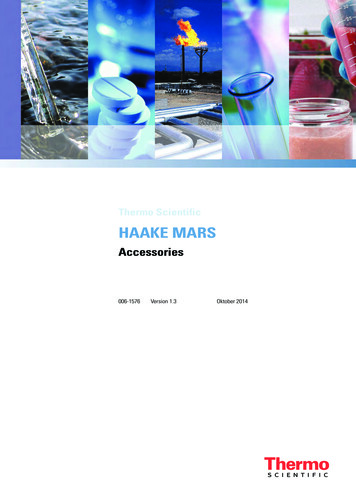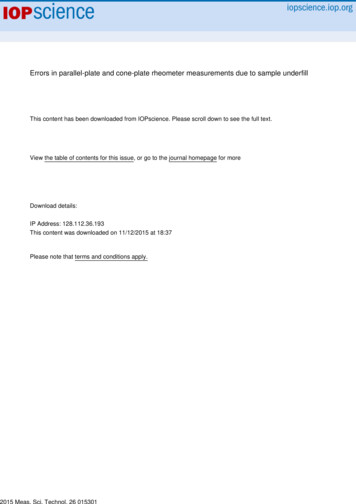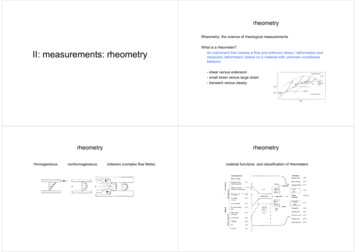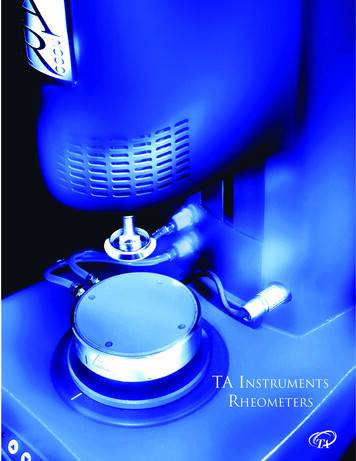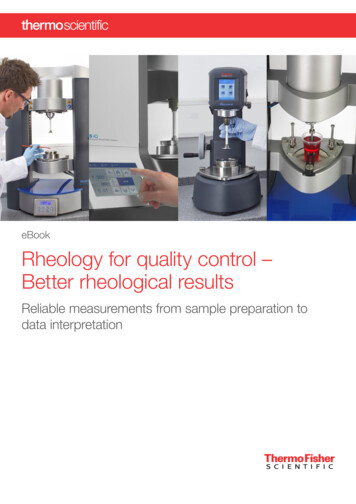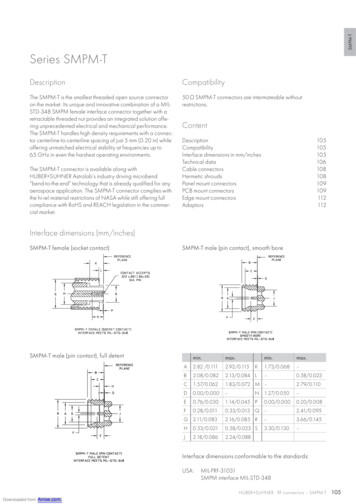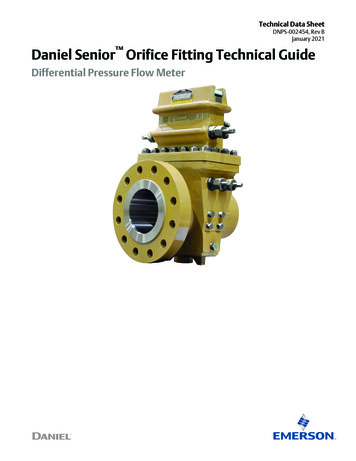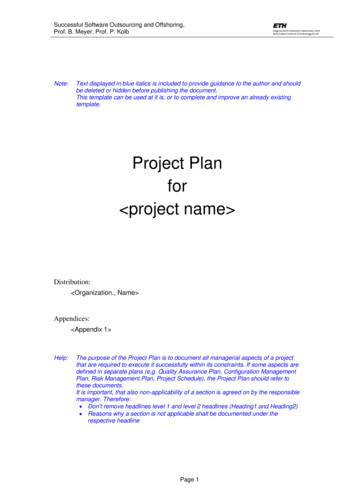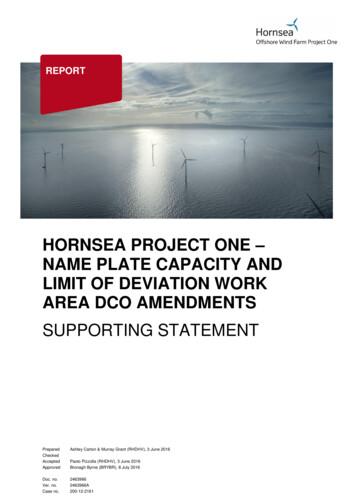
Transcription
REPORTHORNSEA PROJECT ONE –NAME PLATE CAPACITY ANDLIMIT OF DEVIATION WORKAREA DCO AMENDMENTSSUPPORTING STATEMENTPreparedCheckedAcceptedApprovedAshley Carton & Murray Grant (RHDHV), 3 June 2016Doc. no.Ver. no.Case no.24639662463966A200-12-2161Paolo Pizzolla (RHDHV), 3 June 2016Bronagh Byrne (BRYBR), 8 July 2016
Table of ContentsDoc. no. 2463966(ver. no. 2463966A)1.Hornsea Project One Offshore Wind Farm .32.The Purpose of this Document .33.Project Parameters – Consented Envelope and proposed changes .54.Materiality of Changes.115.Cumulative Impacts with Subsequent Non- Material DCO amendment .246.Pre- Submission Stakeholder Consultation .257.Conclusion .298.References .30Appendix A- Consented and Proposed Limits of Deviation Coordinates for WindFarm Areas 1, 2 and 3Appendix B – Marine Mammal and Fish Hammer Energy AssessmentAppendix C- Ornithology Collision Risk Modelling
HOW01 DCO Amendments Supporting Statement1.Doc. no. 2463966(ver. no. 2463966A)Hornsea Project One Offshore Wind FarmThe Hornsea Offshore Wind Farm Project One (Hornsea Project One) is the first project to bedeveloped in the Hornsea Zone, with a total generation capacity of 1,200MW. The DevelopmentththConsent Order (DCO) was granted on the 10 of December 2014 and was corrected on 30 April2015 by the Hornsea One Offshore Wind Farm (Correction) Order 2015. The 2014 DCO wassubsequently amended by the Hornsea One Offshore Wind Farm (Amendment) Order 2016. Theundertakers named in the DCO are Heron Wind Limited ("Heron") Njord Limited ("Njord") and Vi AuraLimited ("Vi Aura") (the Project One Companies). Heron and Njord are owned 100% by DONG EnergyWind Power A/S ("DONG Energy"). Vi Aura is owned 100% by Heron.thDONG Energy Wind Power A/S (“DONG Energy”) took over full ownership of the project on the 4February 2015 and will take the project through into construction and operation. Hornsea Project Onewas one of the first eight projects to receive a Contract for Difference (CfD) from the Department ofEnergy and Climate Change (DECC). Construction of the onshore substation commenced in January2016 and Final Investment Decision was taken on the project in February 2016.2.The Purpose of this DocumentThe Project One Companies require an amendment to the Hornsea Project One name plate capacityby 1.5% from 1,200MW to 1,218MW and an amendment to the limits of deviation of the wind farmareas within the overall consented Order Limits in order to amend the internal boundaries of WindFarm Areas 1, 2 and 3. This document outlines the reasons for the changes sought and theimplications of the proposed changes and the case for these changes constituting a non-materialamendment to the Hornsea Project One DCO and Deemed Marine Licences (DML) 1, 2 and 3, thoughthe DMLs will be dealt with through a separate process.2.1Name Plate CapacityThe fundamental driver behind this minor change is the need to reduce the cost of electricity fromoffshore wind, which is a key Government objective. Fewer, larger capacity turbines significantlyreduce costs. DONG Energy made the following public statement in June 2015 when announcing itsdecision to use 7MW turbines on this project:“Our decision to make Siemens the preferred supplier for our Hornsea Project One wind farm is acrucial step in our efforts to lower cost of electricity. The 7MW turbine is an upgrade of the 6MWplatform which we know very well from Westermost Rough in the UK and Gode Wind 1 2 in Germany.Larger and more cost efficient WTGs are key to reach our strategic target of reducing cost of electricityfrom offshore wind to 100 /MWh in 2020.The decision by Siemens to open new production facilities in Hull on the British east coast is a keyfactor in bringing down the cost of WTGs for this project. This preferred supplier agreement will bothhelp reduce the cost of offshore wind and create and retain real jobs in UK.Besides being the preferred turbine for Hornsea Project One, Siemens turbines will also be used at1Race Bank and Walney Extension Phase 2 , which was announced earlier in 2015.”1Race Bank will use a 6MW turbine and Walney Extension Phase 2 will use a 7MWPage 3/30
HOW01 DCO Amendments Supporting StatementDoc. no. 2463966(ver. no. 2463966A)DONG Energy is leading the offshore wind market in being prepared to commit to larger capacityturbines which can then be proved in the water for the benefit of the wider industry and delivery ofenergy security and climate change goals. In the case of Hornsea Project One, DONG Energy hasalready made, in June 2015, a contractual commitment to Siemens to secure the 7MW turbine for theproject.The added benefit of using fewer, larger capacity machines is that it is normally the case that the vastmajority of the impacts of the project are significantly reduced, compared to using a larger number ofsmaller capacity turbines. In other words, the vast majority of the ‘worst case’ impacts in a givenproject envelope are associated with the largest number of (smaller) turbines. This means thatselecting the 7MW turbine will mean a clear overall benefit in terms of reduced impacts.The corollary to the use of the 7MW turbine is that it is essential that the maximum use is made of theDCO which has been granted, for the overall economics of the project.The DCO for Hornsea Project One defines the "authorised development" as:"The nationally significant infrastructure project comprises two or, subject to paragraph 3, threeoffshore wind generating stations with a combined gross electrical output capacity of up to 1,200MWas follows—".The term ‘gross electrical output capacity’ is not defined in the DCO and there is no statutory definitionor definition within case law. DONG Energy has taken it to mean ‘aggregate name plate capacity’.The name plate capacity of the wind farm is defined as the name plate capacity rating of a WTGmultiplied by the number of turbines. It could, however, be argued that the aggregate output capacityof the wind farm should be measured at the export side of offshore substations, as that is a moremeaningful measurement in electrical system terms. This output will always be slightly lower than thenameplate capacity, due to array cable losses between the turbines and the substations and atHornsea Project One will not exceed 1200MW.DONG Energy has carried out extensive analysis of the proposed layout of the turbines, taking intoaccount the need to maximise energy yield and the various constraints in the DCO and afterdiscussions with relevant stakeholders. DONG Energy has concluded that the optimum number ofturbines for the project is 174 turbines of 7MW capacity. Measured at the export side of the offshoresubstations this represents an installed capacity of 1,200 MW. Measured by way of aggregatenameplate it represents a capacity of 1,218 MW, a difference of 1.5%.To avoid any debate as to compliance with the DCO, the Project One Companies propose to increasethe name plate capacity i.e. the gross electrical output capacity stated within the DCO of HornseaProject One from ‘up to 1,200MW’ to ‘up to 1,218MW’. The maximum energy exported to the gridwould not exceed 1,200MW.2.2Internal Wind Farm Boundary ChangesAn amendment is required to the limits of deviation for Wind Farm Areas 1, 2 and 3 (Work Nos 1, 2and 3) detailed within the DCO and DML 1, 2 and 3 to alter their internal boundaries within the OrderPage 4/30
HOW01 DCO Amendments Supporting StatementDoc. no. 2463966(ver. no. 2463966A)Limits. This arises from the layout finalisation work referred to above and through discussions with theMaritime and Coastguard Agency and Trinity House on requirements for the layout of Hornsea ProjectOne. The DCO was always structured to allow for two or three wind farms, which would each operateseparately. It was necessary when drafting the DCO to decide the coordinates of the sea areas forboth scenarios i.e. two or three wind farms.DONG Energy has decided to use the DCO to construct three wind farms. Part of the finalisation of thedesign of the three wind farms has involved deciding which turbines will 'belong' to which wind farm.This analysis has led to a different allocation of the total sea area within the Order Limits across thethree wind farms than that which is currently provided for in the DCO in the 'three wind farm' scenario.This means that the sea area needs to be re-allocated between the wind farms under the DCO, byaltering the relevant coordinates. No other changes are involved. After discussions with DECC it hasbeen concluded that the appropriate route for this change is a non-material amendment to the DCO,rather than the use of the transfer of benefit provisions between undertakers under Article 34 of theDCO. These revised boundaries will be aligned with the project areas in the lease documentation withThe Crown Estate and the Contract for Difference documentation.The amendments that will be required to the DCO to reflect these proposed changes are shown in thetrack changed version of the DCO which is enclosed within a separate appendix of this application. Adraft Amendment Order to give effect to all proposed changes is enclosed within a separate appendixof this application.2.3Structure of the DocumentThe structure of the document is outlined below:Section 3Section 4Section 5Section 6Section 7Project Parameters – Consented Envelope and Proposed ChangesAssessment of MaterialityCumulative Impacts with Subsequent Non- Material DCO amendmentPre- Submission Stakeholder ConsultationConclusion3.Project Parameters – Consented Envelope and proposed changes3.1Name Plate Capacity AmendmentThe Hornsea Project One Environmental Statement (ES), as submitted with the DCO, stated worstcase parameters. The stated name plate capacity of 1,200MW was used to determine the compositionand numbers of turbines required for Hornsea Project One under different permutations. It was not, initself, a consideration used for environmental assessment (Chapter 3 - Project Description, Table 3.4of ES).As explained above, the Project One Companies propose to increase the name plate capacity ofHornsea Project One to 1,218 MW. The potential effect of this change on the worst case parametersas detailed in the ES are detailed in Table 3.1. These are the only parameters relevant to theproposed name plate capacity change and therefore the only ones presented.Page 5/30
HOW01 DCO Amendments Supporting StatementTable 3.1Doc. no. 2463966(ver. no. 2463966A)WTG and inter array cabling worst case parameters and required design envelop changesassociated with an increase in name plate capacity. (Parameters are taken from Table 3.4and 3.13 respectively of the Hornsea Project One ES, with details of final consentedparameters from the DCO)ESES MaximumMinimumNumber of WTGs 332WTG3.6 ��)Project capacity1,200(MW)Parameter value asdetermined by DCODCO consented up to 240Based upon a maximumnumber of turbines of 240(with no mix of turbinecapacity included) theminimum turbine size is5MW. Up to an 8MWturbine was assessedwithin the ES.1,200Proposed Change fromConsented ParametersNo ChangeNo Change (though themaximum allowablenumber of 6MW, 7MWand 8MW turbines, wouldbe 203,174,152respectively and allremain below 240 numberof turbines)1,218WTG spacing (m)924-924No changeHub height (m)Upper blade tipheight (m)Lower blade tipheight (m)RELATIVE T O Rotor diameter(m)Foundation type82-20082200No changeNo change22-22No change-178178No changeMonopile, Jacket, GravityBase (including monosuction caisson)No changeSeabed areaaffected per2WTG (m )-6,362No changeProject totalseabed area2affected (m )Spoil Arisings3per WTG (m )-Monopile,Jacket, GravityBase (includingmono suctioncaisson)6,362 (Per WTG,includes scour,based on Jacket(Suction Piles)2,112,093N/ANo final design, will notchange-17,839N/AProject spoil3volume (m )-1,721,262(Based on GBF)N/ATotal combinedlength of interarray cable (km)Seabed AreaAffected by interarray cable2protection (m )InstallationMethods-450450-450,000450,000No final design, willremain within consentedlimitNo final design, willremain within consentedlimitNo final design, willremain within consentedlimitNo final design, willremain within consentedlimitElementPile DrivingJetting, ploughing, trenching,rock-cutting, surface laying,pre-laying works asnecessary, and installation ofscour protection. Dependenton ground conditions.Up to 2300KJ hammer for thelargest monopoles.N/ANo changeN/AUp to 2300KJ hammer forthe largest monopoles.Page 6/30
HOW01 DCO Amendments Supporting Statement3.1.1Doc. no. 2463966(ver. no. 2463966A)Turbine Capacity Scenarios for 1,218MW Name Plate CapacityDONG Energy is not proposing to make any changes to the maximum number of turbines, size ofturbines or methods of construction which are consented within the DCO. During the examination forHornsea Project One, mitigation for the scheme for the impacts on birds was provided through the2removal of the 3.6MW turbine from the project design envelope . This resulted in a design envelopecomprising turbine ranges from 5 – 8 MW, as such the DCO as consented was based uponassessments of 150 x 8MW and 240 x 5MW WTGsAlthough 174 7MW turbines is now the intended scenario that Hornsea Project One will employ, thisproject design envelope refinement is not part of the DCO amendment. As such if the amendment toincrease the name plate capacity is granted it would also permit the use of up to 203 6MW or 1548MW turbines. To generate a name plate capacity of 1,218MW using 5MW turbines would require atotal of 243 turbines, which would exceed the DCO consent of 240 turbines and therefore this optioncannot be used to generate a maximum capacity of 1,218MW.The environmental effects of the use of 6MW, 7MW and 8MW turbines has been considered andassessed within this report to ensure that the increase in capacity would not exceed the worst casescenario assessed in the ES under any consented turbine scenario. Note that the Project OneCompanies are not considering using a combination of different capacities of turbines to reach therequired name plate capacity.Table 3.2 lists the realistic WTG scenarios which can be implemented to generate a name platecapacity of up to 1,218MW. As noted in Table 3.1, this involves an increase in the maximumpermissible number of 6MW, 7MW and 8MW turbines by 3, 3 and 2 respectively, compared to the1,200MW name plate capacity. The key issue then is whether any of these minor increases has aneffect on any worst case scenario in the ES, and if so whether that could justify the change beingregarded as material. This is considered in detail in Section 4, where it is concluded that there is noeffect on any worst case scenario.All turbine capacity and numbers of turbines considered are within the headline parameters consentedwithin the DCO. Whilst the analysis in this Statement considers the full permissible range of 5MW to8MW, the commercial reality is that the chance of DONG Energy constructing anything other than7MW turbines is extremely remote. This is because, as noted above, it already has a contractualcommitment with Siemens to deliver 7MW machines for Hornsea Project One. In addition DONGEnergy is required to meet key milestone dates in the construction and commissioning of the project tocomply with the Contract for Difference awarded by DECC in 2013, which was and is fundamental tothe commercial viability of the project. To change to a different turbine capacity would involve a majordelay to the entire project, put the Contract for Difference under threat and incur major expense.Table 3.2Capacity and number of turbine to generate a name plate capacity of up to 1,218MWCapacity of turbineNo of turbinesName Plate is is covered in the Applicant’s Ornithological Summary Appendix J to the Response submitted for Deadline VII ApplicationReference: EN010033Page 7/30
HOW01 DCO Amendments Supporting Statement3.2Doc. no. 2463966(ver. no. 2463966A)Internal Wind Farm Area Boundaries AmendmentHornsea Project One is divided into three distinct Wind Farm Areas. These correspond to ‘WorkNumbers’ within the DCO. Work Numbers are listed in Part 1 of Schedule 1 to the DCO and aredefined by reference to the Wind Farm Area in which they are to be situated.Wind Farm Area 1 (Work No.1) is permitted to comprise up to 80 or, if no part of Wind Farm Area 3(Work No.3) is constructed, up to 120 WTGs. It also includes a network of inter-array cables betweenthe WTGs and substations and (potentially) an offshore accommodation platform which may beconnected to one of the OSSs.Wind Farm Area 2 (Work No. 2) is permitted to comprise up to 80, or, if no part of Wind Farm Area 3(Work No.3) is constructed, up to 120 WTGs fixed to the seabed. It also includes a network of interarray cables between the WTGs and substations and (potentially) an offshore accommodationplatform which may be connected to one of the OSSs.Wind Farm Area 3 (Work No.3) is permitted to comprise up to 80 WTGs. It also includes a network ofinter-array cables between the WTGs and substations and (potentially) an offshore accommodationplatform which may be connected to one of the OSSs.Article 3 of the DCO grants development consent to the following undertakers: Heron Wind Limited (Heron) to carry out all other authorised works, including the construction,maintenance and operation of Work No. 1;Njord Limited (Njord) to construct, maintain and operate Work No. 2; andVi Aura Limited (Vi Aura) to construct, maintain and operate Work No. 3.DONG Energy is the owner of Njord and Heron (which owns Vi Aura) and so has full control overHornsea Project One.Wind Farm Area. 1, 2 and 3 were designed to allow either of the following scenarios in the sameoverall total sea area: Two wind farms (Wind Farm 1 and 2) built up to 120 WTGs in each area; orThree wind farms (Wind Farm 1, 2 and 3) built up to 80 WTGs in each area.The Project One Companies have decided to take forward three wind farm projects.Through continued development of Hornsea Project One and in finalising the layout for the WTGs ithas become apparent that the current internal boundaries of Wind Farm Areas 1, 2 and 3 would leadto the following technical consequences:1) A suboptimal layout with significant additional geotechnical survey required2) Three different sized offshore sub stations, requiring the design process to be re-initiatedcausing significant programme delay.Page 8/30
HOW01 DCO Amendments Supporting StatementDoc. no. 2463966(ver. no. 2463966A)The Project One Companies propose to amend the limits of deviation for Work Nos. 1, 2 and 3 set outby reference to coordinates in Tables 1, 2 and 3 in Part 1 of Schedule 1 to the DCO. The sameamendment would also need to be made to the coordinates set out in Table 1 in Schedule 8, Table 1in Schedule 9 and Table 1 in Schedule 10 to the Order, which contain the associated Deemed MarineLicences (DML) for Work Nos. 1, 2 and 3. The latter will need to be done through a separateapplication to the MMO as it is not possible for the DCO amendment regime to amend a DML.No changes are required to the limits of deviation for Work Nos 4 - 12.The consented and proposed limits of deviation are given in Appendix A. Figure 1 illustrates theexisting consented and proposed amendments to Wind Farm Areas 1, 2 and 3 boundaries.2Table 3.3 below shows the relative sea areas in km between the Wind Farm Areas under the existingand proposed coordinates.Table 3.32Relative km sea bed areas for the current andFarm Areas 1, 2 and 3.Wind Farm AreasExisting relative seaareas2(km )Wind Farm Area 1150.95Wind Farm Area 2Wind Farm Area 3Total132.67123.71407.33proposed limits of deviation for WindProposed2(km )119.14relativeseaareas129.34158.85407.33The number and distribution of WTGs within the three Wind Farm Areas will remain as consentedwithin the DCO.Based on the project’s decision to use 174 7MW turbines it is intended that each Wind Farm Area willcontain up to 58 WTGs in each area. However, this project envelope refinement is not part of the DCOamendment because these numbers are within what is already permitted by the DCO.All other parameters with the ES and DCO are unaffected by the changes to the limits of deviation ofthe Wind Farm Areas which demarcated the internal boundaries between the Wind Farm Areas. Assuch no further assessment of the changes of the internal boundaries of the Wind Farm Areas isrequired.Page 9/30
HOW01 DCO Amendments Supporting StatementDoc. no. 2463966(ver. no. 2463966A)Page 10/30
HOW01 DCO Amendments Supporting Statement4.Doc. no. 2463966(ver. no. 2463966A)Materiality of ChangesThere is no statutory definition of what constitutes a material or non-material amendment for thepurposes of Schedule 6 of the Planning Act 2008 and Part 1 of the 2011 Regulations.However, the Government has recently issued guidance on this point. Criteria for determiningwhether an amendment should be material or non-material is outlined in the Department forCommunities and Local Government (DCLG's) “Planning Act 2008: Guidance on Changes toDevelopment Consent Orders” (December 2015). Paragraphs 9 -16 of this document sets out the fourcharacteristics which act to provide an indication on whether a proposed change is material or nonmaterial. The following characteristics are stated to indicate that an amendment is more likely to beconsidered 'material’.1) A change should be treated as material if it would require an updated EnvironmentalStatement (from that at the time the original DCO was made) to take account of new, ormaterially different, likely significant effects on the environment).2) A change is likely to be material if it would invoke a need for a Habitats RegulationsAssessment. Similarly, the need for a new or additional licence in respect of EuropeanProtected Species is also likely to be indicative of a material change.3) A change should be treated as material that would authorise the compulsory acquisition ofany land, or an interest in or rights over land that was not authorised through the existingDCO.4) The potential impact of the proposed changes on local people will also be a consideration indetermining whether a change is material.The proposed amendment to the DCO in relation to the change to the name plate capacity hasbeen considered in light of these four characteristics as presented in the following Sections 4.1.1to 4.1.4.4.1Materiality of Change to Name Plate Capacity4.1.1EIA considerations1) A change should be treated as material if it would require an updated Environmental Statement(from that at the time the original DCO was made) to take account of new, or materially different,likely significant effects on the environment.).Table 4.1 compares the environmental topics and the potential effects and impacts that wereidentified within the Hornsea Project One ES with the proposed increase to the name plate capacitywithin the DCO. Consideration has been given to the effects of the proposed change and whetherthese changes could result in impacts of significance (in EIA terms) or greater significance to thoseidentified in the existing assessment as submitted to the Secretary of State in July 2013.Page 11/30
HOW01 DCO Amendments Supporting StatementDoc. no. 2463966(ver. no. 2463966A)Table 4.1:Assessment of the increase in the Hornsea Project One name plate capacity from 1,200MW to 1,218MW and effect on EIA topic impactsignificanceEIA TopicChanges in EffectChange in Impact SignificanceMarineProcessesEffects identified on marine processes associated withthe construction, operation and decommissioning ofHornsea Project One within the ES included: increased suspended sediment concentrationsand deposition of material on the seabed;changes to seabed morphology hydrodynamicsand sediment regime, andchanges to tidal and wave regimeThe assessment was based upon a worst case of 332WTGs and 450km of inter-array cable. The DCOsubsequently consented 240 WTGs. Foundationsrequired for the WTGs remain within the maximaconsented.As there will be a reduction in the infrastructurerequired (e.g. 174 7MW WTGs) the numerical valuesassociated with the effects (e.g. volume of suspendedsediment) would therefore decrease from the maximapredicted in the ES. However, this is not considered tochange the assessed magnitude of effect from low.The name plate capacity of the wind farm is not referred to in the worst case in the assessmentundertaken within this chapter of the ES. Rather, the impacts identified on marine processes are causedby the number, physical footprint and installation methods of the WTGs and their associatedinfrastructure.All turbine scenarios are within the consented case in terms of the number of WTGs (save that for the6MW, 7MW and 8MW WTGs, more turbines could be constructed as indicated below) and their physicalfootprint as demonstrated below. Installation methods will remain as consented.Number of WTG’sConsented maximum 240 (NB 240 5MW turbines is 1,200)6MW turbine scenario 203 (being 3 more than with the 1,200MW limit)7MW turbine scenario 174 (being 3 more than with the 1,200MW limit)8MW turbine scenario 152 (being 2 more than with the 1,200MW limit)Sea bed footprint2Consented maximum for WTG monopile foundations 340,0560m (size per foundation2 1,419m )26MW turbine scenario 288,057m27MW turbine scenario 246,906m28MW turbine scenario 215,688m2Consented maximum for WTG jacket foundations (driven/drilled piles) 169,680m (size per2foundation 7,07m )26MW turbine scenario 143,521m27MW turbine scenario 123,018m28MW turbine scenario 107,464m2Consented maximum for WTG jacket foundations (suction piles) 1,526,880m (size per2foundation 6,362m )26MW turbine scenario 1,291,486m27MW turbine scenario 1,106,988 mPage 12/30
HOW01 DCO Amendments Supporting StatementEIA TopicDoc. no. 2463966(ver. no. 2463966A)Changes in EffectChange in Impact Significance8MW turbine scenario 967,024m22Consented maximum for WTG gravity base foundations 1,526,880m (size per foundation 26,362m )26MW turbine scenario 1,291,486m27MW turbine scenario 1,106,988 m28MW turbine scenario 967,024mThere will therefore be no change in impact significance from the proposed name plate capacitychange.Benthic Subtidaland IntertidalEcologyEffects identified on benthic subtidal and intertidalecology associated with the construction, operation anddecommissioning of Hornsea Project One within the ESincluded: All turbine scenarios are within the consented case in terms of the number of WTGs and their physicalfootprint as demonstrated above for Marine Processes. Installation methods will remain as consented.There will therefore be no change in impact significance from the proposed name plate capacitychange.increased suspended sediment concentrationsand deposition;temporary habitat disturbance and loss;long term habitat loss;electric and magnetic field emissions (EMF) fromsubsea cablesintroduction of new habitat, andhabitat disturbance via scour and vessel activitiesduring operation.The assessment was based upon a worst case of 332WTGs and 450km of inter-array cable. The DCOsubsequently consented 240 WTGs. Foundationsrequired for the WTGs remain within the maximaconsented.The decreases in numerical values associated with theeffects (e.g. habitat loss, disturbance) are notconsidered to change the assessed magnitude ofeffects from the range of negligible to low.The worst case scenario for EMF effects relates to thePage 13/30
HOW01 DCO Amendments Supporting StatementEIA TopicDoc. no. 2463966(ver. no. 2463966A)Changes in EffectChange in Impact Significancelevel of current passing through the cables. Foroffshore aspects the inter-array cables was consideredto be 70kV and for the export cables it was consideredat 400kV. For onshore cables the worst case wasbased on an assumption of 400kV for the substation,2,000A (two trenches with two cables in each - HVDC)and 680kV (three trenches with three cables in each HVAC).Fish andShellfishEcologyIt has been confirmed by DONG Energy engineers thatthese values will not change.Effects identified on fish and shellfish ecologyassociated with the construction, operation anddecommissioning of Hornsea Project One within the ESincluded: underwater noise;increased suspended sediment concentrations;sediment deposition;temporary habitat disturbance;long term habitat loss;EMF emissions from subsea cables;Underwater noise from foundation piling and otherconstruction activities;introduction of new habitat, andpotential for reduced fishing pressure duringoperation.The assessment was based upon a worst case of 332WTGs and 450km of inter-array cable. The DCOsubsequently consented 240 WTGs. Foundationsrequired for the WTGs remain within the maximaconsented.The name plate capacity of the wind farm is not referred to in the worst case in the assessmentundertaken within this chapter of the ES. Rather the impacts identified on fish and shellfish ecology areassociated with the number and physical presence of the WTG and piling associated with the number offoundations, the below sea level infrastructure (namely the foundations) and the piling activities requiredto install these foundations.All WTG scenarios are within the consented case in terms of the number of WTGsand their physicalfootprint as demonstrated above for Marine Processes. Installation methods will remain as consented.The Project One Companies are currently in discussions with the MMO and Natural England to incre
The name plate capacity of the wind farm is defined as the name plate capacity rating of a WTG multiplied by the number of turbines. It could, however, be argued that the aggregate output capacity of the wind farm should be measured at the export side of offshore substations, as that is

